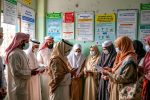Malaria Prevention Information You Should Know
Malaria, a life-threatening disease spread by mosquitoes, tragically claims over 600,000 lives yearly, mostly children in Africa. Protecting yourself is crucial, especially when traveling to high-risk areas. Learn how to shield yourself and your family with preventive medications, mosquito nets, and repellents. Discover the latest advancements in malaria vaccines and global strategies to combat this devastating disease. Read on to safeguard your health and contribute to a malaria-free future.
Important information

- Malaria is a life-threatening disease spread by infected mosquitoes. Pregnant women and young children are most at risk.
- Preventive measures include using insecticide-treated bed nets, wearing protective clothing, applying insect repellent (like DEET or Icaridin), and taking antimalarial medication.
- Consult a doctor before traveling to a malaria-risk area to discuss personalized prevention strategies, including the right medication (chemoprophylaxis) and dosage.
- The RTS,S/AS01 (Mosquirix) vaccine offers partial protection against malaria, especially for young children, and is recommended by the WHO. Other preventive measures are still necessary.
- Eliminating mosquito breeding grounds (standing water) and using insecticides are crucial for community-level malaria control.
Why is Malaria Prevention Important?
Malaria is a life-threatening disease transmitted by infected mosquitoes, posing a significant risk, especially to pregnant women and young children. Prevention is paramount, and swift diagnosis and treatment are essential for survival. Early intervention can be life-saving.Effective preventive measures drastically reduce malaria’s impact, improving public health and easing the strain on healthcare systems. Protecting yourself involves avoiding mosquito bites through methods like using insect repellent and mosquito nets. Taking prescribed antimalarial medication, particularly in high-risk regions, offers powerful protection.
Global Malaria Burden and Its Effects
Malaria is a serious global health threat, causing widespread illness and a significant number of deaths. In 2021 alone, there were approximately 247 million malaria cases and 619,000 deaths. The WHO African Region is most affected by this devastating disease, with children under five at the highest risk. Beyond the immense human cost, malaria also hinders socioeconomic progress by diminishing productivity and economic growth in affected areas.
WHO Global Technical Strategy for Malaria
The WHO’s global malaria strategy aims to drastically reduce both cases and fatalities. It encourages nations to maintain robust malaria control programs, ensuring everyone can access prevention, diagnosis, and treatment. Improved surveillance is also emphasized, along with the crucial role of research and development in ultimately defeating malaria.
Malaria Elimination Efforts
Combating malaria requires a multi-pronged approach, encompassing mosquito control, effective treatment, preventative education, and global collaboration. Insecticide-treated bed nets offer crucial protection against mosquito bites. Indoor residual spraying provides another layer of defense by targeting mosquitoes inside homes. Antimalarial drugs are essential for both preventing and treating the illness. Environmental management, particularly minimizing mosquito breeding grounds, is also vital.
Protection
- Insecticide-treated bed nets offer vital protection against mosquito bites.
- Indoor residual spraying targets mosquitoes inside homes.
Treatment and Prevention
- Antimalarial drugs are essential for both preventing and treating malaria.
- Environmental management focuses on reducing mosquito breeding sites.
Assessing Your Risk Before Traveling
Before traveling, assess your risk of malaria by consulting your doctor and researching your destination. Your doctor can provide personalized advice on preventive measures, including medication, based on your health, trip details, and the destination’s risk level. When researching your destination, learn about mosquito exposure, considering factors such as the time of year, altitude, and type of accommodations. Also, consider your personal health, as certain conditions like pregnancy can increase your risk.
Risk Assessment for Travelers
Planning a trip to a malaria-prone region? Consult your doctor to assess your risk and discuss personalized preventive measures, which may include chemoprophylaxis (preventive medication). Also, learn about mosquito avoidance strategies and understand the specific malaria transmission patterns in your destination.
Exposure and Host Assessment
Your risk of mosquito bites is assessed based on several factors: your travel destination, the season, and your planned activities. For example, exploring a jungle poses a greater risk than city sightseeing. Personal factors, such as age and health, also influence risk, with pregnant women and seniors being more vulnerable. This assessment helps determine the best protective measures, like mosquito nets or preventive medicine. Your individual medical history is crucial for creating a personalized prevention plan.
Consulting Healthcare Providers
Before traveling to a malaria-risk area, consult your physician. Discuss your travel plans and medical history so they can assess your risk and prescribe appropriate preventive medication (chemoprophylaxis). Your doctor will also advise you on additional protective measures, pre-travel vaccinations, and necessary precautions for a safe and healthy trip.
Effective Malaria Prevention Strategies
Malaria prevention involves avoiding mosquito bites and taking appropriate medication. Here’s a breakdown of preventive measures:
Personal Protection
- Insecticide-treated bed nets: Sleeping under insecticide-treated bed nets creates a physical barrier against mosquitoes at night.
- Protective clothing: Wearing long sleeves and pants, especially during dawn and dusk when mosquitoes are most active, minimizes exposed skin.
- Insect repellent: Applying insect repellent containing DEET or other EPA-approved ingredients provides an added layer of protection.
Medical Prevention
Antimalarial medication (chemoprophylaxis): Consult your doctor to determine the appropriate antimalarial medication and dosage based on your travel itinerary and individual risk factors. Start the medication before, during, and after your trip as directed.
Community efforts, such as eliminating mosquito breeding grounds, are essential in reducing the overall malaria risk.
Mosquito Avoidance Measures
Protect yourself from mosquito bites by using insecticide-treated bed nets (ITNs). Wear long sleeves and pants for added protection. Apply insect repellent to exposed skin, especially during dawn and dusk when mosquitoes are most active. Eliminate standing water around your home to reduce mosquito breeding grounds. Sleep indoors whenever possible, preferably in a well-screened or air-conditioned room.
Topical Insect Repellents and Icaridin
Icaridin, also known as picaridin, is a potent insect repellent offering excellent protection against mosquito bites. Recommended by the Centers for Disease Control and Prevention (CDC), this EPA-registered repellent provides long-lasting effectiveness. It’s safe for both children and pregnant women when used as directed. Furthermore, it’s gentler on skin than DEET and won’t damage plastics. For reliable and safe mosquito protection, icaridin is an excellent option.
Insecticide-treated Nets (ITNs) and Indoor Residual Spraying (IRS)
Insecticide-treated nets (ITNs) provide a physical barrier against mosquitoes and kill these disease carriers. Indoor residual spraying (IRS) targets resting mosquitoes by applying insecticides to interior walls. Both methods effectively combat malaria, particularly in high-prevalence regions. ITNs offer direct personal protection, while IRS reduces the overall mosquito population. Frequently, these two methods are combined for a more impactful malaria control strategy.
Insecticide-Treated Nets (ITNs)
Provide a physical barrier against mosquitoes.
Kill disease-carrying mosquitoes.
Offer direct personal protection.
Indoor Residual Spraying (IRS)
Targets resting mosquitoes on interior walls using insecticides.
Reduces the overall mosquito population.
Both methods are highly effective in combating malaria, especially in areas with high prevalence. Combining ITNs and IRS often creates a more impactful malaria control strategy.
Personal Protective Measures (PPM)
Wear long sleeves and pants, especially during dawn and dusk, to significantly reduce mosquito bites.
Apply insect repellent containing DEET or Icaridin to all exposed skin. This is essential for effective protection.
Sleep under an insecticide-treated bed net (ITN) for crucial protection against mosquito bites during the night.
Whenever possible, stay in screened or air-conditioned rooms to further deter mosquitoes.
For the best protection against malaria, combine all of these preventive measures.
Vector Control Techniques
Mosquito control is crucial for protecting ourselves from mosquito-borne diseases. One effective approach is to reduce their population by eliminating breeding grounds, such as standing water. Insecticides offer another line of defense, targeting both larvae in water (larviciding) and adult mosquitoes. For the latter, indoor residual spraying (IRS) coats surfaces with insecticide, killing mosquitoes on contact. Insecticide-treated nets (ITNs) provide a physical barrier and also eliminate mosquitoes through insecticide contact, offering additional protection against mosquito-borne illnesses.
Eliminate Breeding Grounds
Reduce mosquito populations by eliminating standing water where they breed.
Target Mosquitoes with Insecticides
Use larvicides for larvae in water and target adult mosquitoes with IRS and ITNs.
Indoor Residual Spraying (IRS)
IRS coats surfaces with insecticide, killing mosquitoes on contact.
Insecticide-Treated Nets (ITNs)
ITNs provide a physical barrier and eliminate mosquitoes through insecticide contact.
Medications for Malaria Prevention
Protecting yourself from malaria requires preventive medication, sometimes called chemoprophylaxis. Several options are available:
- atovaquone-proguanil,
- mefloquine,
- doxycycline, and
- primaquine.
The ideal choice depends on several factors, including your destination, overall health, and potential side effects. A discussion with your doctor is essential for personalized guidance. Taking your prescribed medication precisely as directed is vital for its effectiveness.
Chemoprophylaxis: Taking Preventive Medication
Protecting yourself from malaria involves taking preventive medicine, known as chemoprophylaxis. Several effective antimalarial drugs are available. These include atovaquone-proguanil, doxycycline, mefloquine, and primaquine. The ideal choice depends on several factors: the specific region you’re visiting, the intensity of malaria transmission there, your overall health, and potential drug side effects. Begin taking your chosen medication one to two days before entering the malaria-risk area. Continue taking it for seven days after leaving to ensure complete protection.
Choosing the Right Chemoprophylaxis
Choosing the right malaria prevention medication is crucial for your health and safety. Several factors influence this decision, including your travel destination, its malaria risk level, and your personal health conditions. Consulting with a healthcare professional is essential for personalized guidance. They can assess your individual needs and recommend the most appropriate medication. Here’s a step-by-step guide to help you prepare for your consultation:
Research your destination. Understand the specific malaria risk in the areas you’ll be visiting. This information is crucial for determining the necessary precautions.
Assess your health. Consider any pre-existing health conditions, allergies, or medications you’re currently taking. This information will help your healthcare provider choose a safe and effective malaria medication.
Schedule a consultation. Book an appointment with a healthcare professional specializing in travel medicine. They can provide tailored advice based on your unique circumstances.
Discuss medication options. Talk to your doctor about the potential benefits and side effects of different malaria medications, such as Atovaquone-proguanil, doxycycline, and mefloquine. Ensure you understand how to take the medication correctly.
Follow recommendations. Adhere to your healthcare provider’s instructions regarding medication dosage and any additional preventive measures, such as using insect repellent and mosquito nets.
By following these steps, you can significantly reduce your risk of contracting malaria and ensure a safe and healthy trip.
Preventive Chemotherapy Guidelines
Preventive chemotherapy is crucial for avoiding malaria. This involves taking antimalarial medication before, during, and after trips to malaria-prone regions. Your doctor will determine the appropriate medicine and dosage based on factors like your destination, trip length, and medical history. Starting your medication before potential exposure and continuing it after your return is vital for maximum protection. Strictly following your doctor’s prescribed regimen is essential for the treatment’s success. Consult your doctor for personalized advice and to determine the best preventive measures for your specific situation.
Consult your doctor. Discuss your travel plans, medical history, and any potential risks with your doctor to determine the most suitable antimalarial medication and dosage.
Start medication before travel. Begin taking the prescribed antimalarial medication before your trip to establish protection against potential exposure to malaria parasites.
Continue medication during travel. Maintain the prescribed dosage of antimalarial medication throughout your stay in the malaria-prone region.
Complete medication course after travel. Continue taking the medication for the prescribed duration after your return to ensure complete elimination of any potential parasites and maximize protection.
Adherence to Medication Regimens
Adhering to your malaria medication regimen is vital. Complete the prescribed course, even after returning home, to ensure all parasites are eradicated and prevent malaria’s development.
Special Considerations for Different Groups
Expectant mothers are especially vulnerable to severe malaria, an infection that can cause complications such as anemia, premature delivery, or even stillbirth. Preventative treatment with sulfadoxine-pyrimethamine (SP) is crucial in high-risk areas, even for women without symptoms.
Young children and adolescents are also highly susceptible due to their underdeveloped immune systems. Protecting them is vital and involves preventative medication, insecticide-treated bed nets, and protective clothing.
Most antimalarial medications, including chloroquine, mefloquine, and atovaquone-proguanil, are generally safe for breastfeeding mothers. However, consulting a doctor is always recommended for personalized advice to ensure the well-being of both mother and child.
Pregnant Women and Malaria Prevention
Pre-travel arrangements can be stressful. Streamline your travel process with our comprehensive guide, covering everything from visa applications to packing tips. Here’s what you need to know:
Visa and Passport
Ensure your passport’s validity extends at least six months beyond your intended travel dates. Research visa requirements specific to your destination and nationality. Initiate the visa application process well in advance to avoid last-minute delays.
Flights and Accommodation
Book flights and accommodations that align with your budget and travel style. Consider factors like travel time, airline reputation, hotel amenities, and proximity to attractions. Leverage online travel agencies and comparison websites to secure the best deals.
Travel Insurance
Protect yourself against unforeseen circumstances with comprehensive travel insurance. Coverage should include medical emergencies, trip cancellations, lost baggage, and other potential disruptions. Evaluate different policies to find the right balance of coverage and cost.
Packing Essentials
Create a packing list tailored to your destination’s climate and planned activities. Pack versatile clothing items, essential toiletries, necessary medications, and any specialized gear. Consider using packing cubes to organize your luggage efficiently.
Step 1: Research and Plan
Thoroughly research your destination, considering climate, local customs, and attractions. Develop a flexible itinerary that balances planned activities with opportunities for spontaneous exploration.
Step 2: Book and Confirm
Book flights, accommodation, and any pre-booked tours or activities. Confirm all reservations and ensure you have electronic or printed copies of booking confirmations.
Step 3: Pack and Prepare
Pack your luggage according to your planned activities and destination climate. Prepare essential documents like passport, visa, travel insurance, and any required health certificates.
Step 4: Stay Informed
Check for any travel advisories or updates related to your destination. Stay informed about local regulations and any potential disruptions that may affect your trip.
Step 5: Enjoy Your Trip
Embrace the travel experience, be open to new cultures, and create lasting memories. Stay safe and responsible throughout your journey.
Infants, Children, and Adolescents
Children and adolescents are more vulnerable to severe malaria and require extra care. Consult a doctor about appropriate preventive medications and strategies to minimize mosquito bites, considering the child’s age and individual health needs.
Considerations for Breastfeeding Mothers
Nursing mothers should consult their doctors to determine the safest malaria prevention measures to protect themselves and their babies. This will help ensure the health of both mother and child.
Malaria Vaccines: Current Developments
The World Health Organization (WHO) recommends widespread use of the RTS,S/AS01 vaccine, also known as Mosquirix. This is the first malaria vaccine to achieve this milestone. Another promising vaccine candidate, R21/Matrix-M, is currently in clinical trials. Both vaccines target *Plasmodium falciparum*, the deadliest malaria parasite. They offer crucial partial protection, especially for young children, in the fight against this disease.
RTS,S/AS01 Malaria Vaccine
The World Health Organization (WHO) has approved Mosquirix (RTS,S/AS01), the world’s first malaria vaccine. This vaccine targets *Plasmodium falciparum*, the deadliest malaria parasite prevalent in sub-Saharan Africa. It is primarily for children aged 6 weeks to 5 years living in moderate-to-high transmission areas. The vaccine is administered in four doses: three monthly doses followed by a fourth dose 15-18 months later. Mosquirix offers partial protection, reducing severe malaria cases and deaths. While it doesn’t eliminate malaria risk completely, it significantly contributes to prevention. Other protective measures, such as insecticide-treated nets, remain essential.
R21/Matrix-M Vaccine
The R21/Matrix-M malaria vaccine has demonstrated promising results in initial clinical trials, offering a beacon of hope in the global fight against malaria.
Effectiveness and Recommendations
Scientists continually assess malaria vaccines such as RTS,S/AS01 and R21/Matrix-M, analyzing their effectiveness and considering the latest scientific data. Researchers also examine malaria transmission patterns in diverse regions to formulate tailored vaccine recommendations, recognizing that each area presents unique challenges.

















